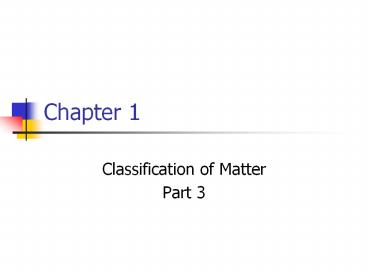Classification of Matter - PowerPoint PPT Presentation
Title:
Classification of Matter
Description:
Chapter 1 Classification of Matter Part 3 Classification of Matter Classification of Matter Pure Substances A pure substance has a fixed composition. – PowerPoint PPT presentation
Number of Views:123
Avg rating:3.0/5.0
Title: Classification of Matter
1
Chapter 1
- Classification of Matter
- Part 3
2
Classification of Matter
3
Classification of Matter
4
Pure Substances
- A pure substance has a fixed composition.
- Pure substances are either compounds or elements.
- A pure substance differs from a mixture in the
following ways - Every sample of a given pure substance has
exactly the same characteristic
properties. - Every sample of a given pure substance has
exactly the same composition.
5
Mixtures
- A mixture is a blend of two or more kinds of
matter, each of which retains its own identity
and properties - mixed together physically
- can usually be separated
- Heterogeneous
- Homogeneous
6
Heterogeneous mixtures
- Are not uniform in composition.
- Examples
- Sand and salt
- Sand and water
7
Homogeneous mixtures
- Uniform in composition,
- Example
- Salt and water
- Nitrogen and oxygen in air.
- Copper and silver in sterling silver.
8
Which is which?
9
(No Transcript)
10
Solutions
- Homogeneous mixtures are also known as solutions.
- Any part of a mixture with uniform composition is
known as a phase. - Salt and water one phase
- Oil and water 2 phases
11
Parts of a solution
12
Types of solutions Types of solutions Types of solutions Types of solutions Types of solutions Types of solutions Types of solutions
Examples of solutions Examples of solutions Examples of solutions Solute Solute Solute Solute Solute
Examples of solutions Examples of solutions Examples of solutions Gas Liquid Liquid Solid Solid
Solvent Gas Gas
Solvent Liquid Liquid
Solvent Solid Solid
The odor of a solid results from molecules of
that solid being dissolved in the air
Oxygen and other gases in nitrogen (air)
Water vapor in air (humidity)
Ethanol (common alcohol) in water various
hydrocarbons in each other (petroleum)
Carbon dioxide in water (carbonated water)
Sucrose (table sugar) in water sodium chloride
(table salt) in water gold in mercury, forming
an amalgam
Hydrogen dissolves rather well in metals
platinum has been studied as a storage medium
Water in activated charcoal moisture in wood
Steel, duralumin, other metal alloys
13
Separating mixtures
- Physical means are used to separate mixtures.
- Pick it out
- Use a magnet
- But there are other physical means
14
Other methods
15
What other Physical methods?
- Filtration
- Evaporation
- Any method that does not change the physicals
properties of the substances.
16
Pure Substances
- Pure Substances are either Compounds or Elements.
- Compounds are chemically bound elements. They
can be broken down into elements. - Elements cannot be broken down further.
17
Periodic Table
18
Symbols
- A chemical symbol is an abbreviation of the name
of a chemical element. - Natural elements all have symbols of one or two
letters. - Some man-made elements have temporary symbols of
three letters.
19
Regions of the Periodic Table
20
Introduction to the Periodic Table
- The vertical columns of the periodic table are
called groups, or families. - Each group contains elements with similar
chemical properties. - The horizontal rows of elements in the periodic
table are called periods. - Physical and chemical properties change somewhat
regularly across a period.
21
Types of Elements
- Metals
- A metal is an element that is a good electrical
conductor and a good heat conductor. - Properties of metals
- most are solids at room temperature
- malleable - they can be hammered or rolled into
thin sheets - ductile - they can be drawn into a fine wire
- conduct electricity and heat well
22
Chapter 1
Types of Elements
- Metals
- A metal is an element that is a good electrical
conductor and a good heat conductor. - Properties of metals
- most are solids at room temperature
- malleable - they can be hammered or rolled into
thin sheets - ductile - they can be drawn into a fine wire
- conduct electricity and heat well
23
Section 3 Elements
Chapter 1
Types of Elements
- Gold, copper, and aluminum are metals
24
Types of Elements
Chapter 1
- Nonmetals
- A nonmetal is an element that is a poor conductor
of heat and electricity. - Properties of nonmetals
- many are gases
- solids are brittle
- poor conductors of heat and electricity
25
Chapter 1
Types of Elements
- Various nonmetal elements
- (a) carbon, (b) sulfur, (c) phosphorus, and (d)
iodine
26
Types of Elements
Chapter 1
- Metalloids
- A metalloid is an element that has some
characteristics of metals and some
characteristics of nonmetals. - Properties of metalloids
- all metalloids are solids at room temperature
- semiconductors of electricity
27
Section 3 Elements
Chapter 1
Types of Elements
Noble Gases
- generally unreactive
- elements in Group 8A of the periodic table
- gases at room temperature































